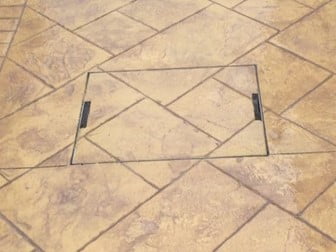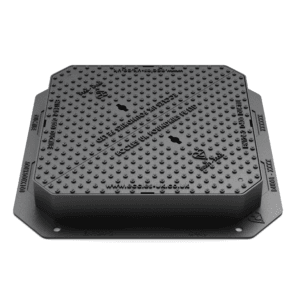Buying a Replacement Manhole Cover: A Comprehensive Guide
When it comes to replacing a manhole cover, many people assume it's a straightforward task. After all, if you can remove the old one, putting a new one in place seems like it would be no big deal, right? However, in reality, replacing a manhole cover is often far more complex than it appears. We receive more inquiries about manhole covers than almost any other product in our underground drainage inventory. This guide aims to walk you through the considerations and steps involved in replacing a manhole cover, how to choose the right one from the vast selection available, and some additional components related to underground drainage systems that you should familiarize yourself with.
Manhole Cover Terminology
Understanding some basic terminology associated with manholes can be quite helpful. While "manhole cover" is the common term, it might be more precise to refer to these items as "drain covers" or "inspection chamber covers," since they sit atop an inspection chamber. Generally, you'll purchase a cover along with its corresponding frame, which is an important detail that often leads to confusion during replacements. The term "clear opening" frequently arises when discussing manhole covers, referring to the size of the opening within the frame beneath the cover. This measurement is more crucial than the cover itself. When sourcing a new cover, ensure you have the correct clear opening size, which should match or exceed the inspection chamber below to facilitate easy access if necessary. The accompanying image should clarify what this term means.

Why Can't You Just Swap Manhole Covers?
Unless your manhole was installed very recently, there's a good chance that you won't find a cover that fits perfectly into the existing frame. Why is this? Well, frames and covers are specifically designed to fit together seamlessly. Even if a cover seems to fit, there's a real possibility that it won't provide the same level of overall strength when paired with a frame it wasn't intended to work with. In some instances, mismatched frames and covers have resulted in serious accidents. In short, this is a task that requires proper execution—regardless of your preference, your installation will likely involve replacing both the frame and the cover.
What Are Recessed Covers?
Today, nearly all manhole covers are designed to sit flush with the surrounding surface. This is a vital health and safety consideration, especially in areas with pedestrian or vehicular traffic. However, even if they sit flush, black grates and manhole covers aren't particularly aesthetically pleasing. If your inspection chamber is beneath decorative surfaces like block paving on a driveway, you'll need a recessed cover to effectively conceal it.

How Do Recessed Manhole Covers Work?
A recessed cover typically has a few inches of recess, placing the actual cover below the height of the surrounding frame, allowing you to block pave over it. You'll still be able to access the lifting points to open the cover using tools, so they're not entirely hidden. These covers are often seen as more visually appealing than those that sit on the surface. You can fill the recess with a finish that matches the texture and color of the surrounding area—blocks, slabs, tarmac, or any driveway finish usually works well.
What Kind of Manhole Do You Need?
Looking at our range of covers and inspection chambers, you'll notice there are many different sizes and specifications to consider, which we will explore below.
Measuring a Manhole
While materials, designs, and styles may vary between manufacturers, the method of measuring remains consistent. The measurement you need is the distance between the walls of the frame with the cover removed—the clear opening. For round chambers, this will be the diameter; for square ones, it will be center-to-center. Double-check this measurement on the system you're replacing and note it down—you'll be looking for this measurement when selecting replacements.
Load Capacity
Next is the 'load capacity'—essentially, how much weight the product can safely support. Different covers have different load capacities for various applications and services. This is critical information to consider if you want to avoid accidents involving people, cars, or lorries falling into your drainage or service access system. If heavy traffic will pass over the cover, you'll need a heavy-duty manhole cover.
The Different Maximum Weight Classes Are:
A Class (A15 – 1.5 tonne loading)
Suitable for light use—such as paths, patios, and gardens. Most recessed designs are A15 class. Usually made of plastic or steel.
B Class (B125 12.5 tonne loading)
Designed for light pedestrian traffic and house driveways. Usually galvanized steel, ductile iron, or plastic composite.
C Class (C250 25 tonne load)
Made for light traffic areas with slow-moving cars and vans. Again, usually galvanized steel, ductile iron, or plastic composite.
D Class (D400 40 tonne loading)
Intended for main road use and public car parks.
E Class (E600 60 tonne loading)
Suitable for very heavy-duty areas like loading bays, warehouses, and industrial parks.
F Class (F900 90 tonne loading)
Made for the heaviest applications—including docks and runways.
If you're unsure which load capacity is right for your application, don't hesitate to reach out—we're always happy to help you select the perfect product.
Do You Need Plastic, Iron, or Galvanized Steel Manhole Covers?
Modern polypropylene plastic manholes are just as strong and durable as iron ones, so material choice matters less than it used to. Galvanized sheet steel covers tend to be lighter and easier to install, making them popular choices. Generally, composite covers are the most cost-effective, with our range starting at just over £30 ex VAT. Ductile iron is slightly more expensive, starting around £52 ex VAT, and prices increase with the maximum weight the product can handle.
If you're working with the correct load capacity, your material choice can come down to aesthetics.
Should You Choose a Square, Triangular, or Round Manhole Cover?
Again, much like the material you choose, the shape of manhole cover is also likely to be influenced by aesthetics. However, there are a couple of practical factors to consider beyond looks. Round manhole covers cannot fall into themselves, and the circular shape makes them the most resistant to earth compression around them. Some rectangular or square-shaped covers are actually split into two triangles. This design is often used on roads because it's less likely to rock backward and forward, reducing wear and preventing damage from slightly raised edges.

Need to Talk to the EasyMerchant Team?
We receive dozens of manhole-related inquiries each month, so if you have any more questions about anything discussed here, feel free to contact our friendly customer service team at 01371 850 120 option 1, and we'll do our best to assist you.
Whether you need further details about installation, how to measure your current fittings, the tools required, our range of accessories—or anything else—we're here to quickly provide all the information you need!
Shop Manhole Covers

Round Manhole Cover 320/470mm
For further assistance or specific queries, feel free to reach out to us anytime—we’re here to help!
Bath Spout,Tub Spout Diverter,Bathtub Diverter,Bathroom Spout
JANGMEN MOON SHOWER SANITARYWARE CO.,LTD , https://www.moonshowerglobal.com